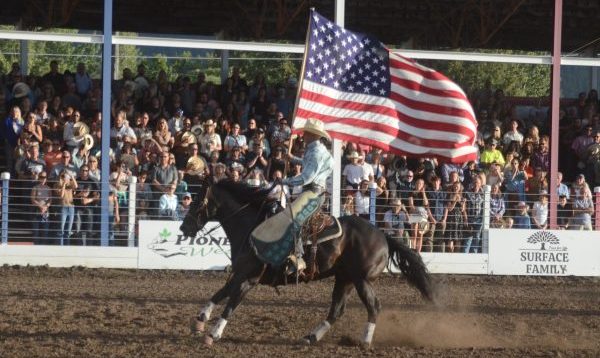ODFW approves killing two wolves in NE Oregon
Published 9:24 am Tuesday, May 3, 2022

- Gray wolf
JOSEPH — The Oregon Department of Fish and Wildlife has issued a kill permit for up to two wolves from the Chesnimnus pack in Wallowa County.
State wildlife biologists determined members of the pack were responsible for two confirmed attacks on livestock between April 25 and 27 on a public grazing allotment north of Joseph, resulting in three dead calves.
Trending
ODFW can authorize lethal take of wolves that prey on livestock after two confirmed depredations in nine months. That is the current standard for “chronic depredation” in Eastern Oregon, where wolves were removed from the state endangered species list in 2015.
Tom Birkmaier, who ranches along Crow Creek, said Tuesday, May 3, that he received the kill permit April 29. He is allowed to take two Chesnimnus pack wolves in Dorrance Pasture or Trap Canyon Pasture, where the kills were confirmed.
The kill permit is good through May 24.
“I asked for the removal of the pack,” Birkmaier said. “They issued me a kill permit for two.”
He said his latest wolf attacks were on April 30, when a cow took wolf bites to protect her calf.
“She saved her calf … she had two bite marks on her ribs,” he said. “I walked that cow and her calf down 7 miles to my ranch and I’m now taking care of them.”
Trending
He said his losses from the killed calves and the one injured Saturday — which he said likely won’t be marketable — amounts to an estimated $4,000.
Birkmaier said he’s been working 20 hours a day over the previous eight or nine days to protect his cattle and use nonlethal methods to deter the wolves.
Ranchers must also remove all carcasses, bone piles and other attractants and be using nonlethal deterrents such as range riders to qualify for lethal take of wolves.
In this case, ODFW reports the livestock producer has a history of using nonlethal deterrents to haze wolves in the area, including flashing lights, radios and hiring a range rider with funding provided by a nonprofit organization.
“I’m trying all the nonlethal methods that I can,” Birkmaier said. “I’ve had a tremendous amount of help from the community.”
“The producer spent several nights in the pasture with his cattle following the first depredation and attempted to haze wolves out of the area on April 26 by shooting in the air over eight wolves he encountered in the pasture,” the agency stated. “Despite these efforts, wolves have continued to visit and have killed additional calves.”
Birkmaier said he’s received assistance from fellow ranchers and residents. In particular, he noted Mike and Mona Rahn, who have a cabin in the area.
“They dropped everything they were doing to help,” he said. “They were literally living with one group of cows.”
He said many others have helped who he will publicly thank at a later time.
“All ranchers work so hard during the calving season and we turn out healthy calves with lots of vigor,” Birkmaier said. “Before wolves were introduced, we didn’t have to worry about them much this time of year. Now it’s at a whole other level of loss, both emotional and financial and many extra hours of work. Ranchers don’t have that extra time … and to have to work day and night to protect them from the wolves that are both nonnative and were introduced.”
The Chesnimus pack numbers at least eight or nine adult and yearling wolves, none of which have a working GPS collar, according to ODFW. The agency says killing two wolves would not be expected to impact the pack’s breeding success.
Roblyn Brown, wolf coordinator for ODFW, said Tuesday that Birkmaier’s April 30 calf losses were expected to be posted on the ODFW website May 3, after the investigation is complete.
She also said it’s possible the number of wolves allowed to be taken under the kill permits could increase.
“The potential to increase the number of wolves (permitted to kill) exists,” she said. “It just depends on if the number of depredations increases.”
ODFW released its annual wolf report on April 19, showing the state’s minimum wolf population remained virtually flat in 2021 while the number of wolf deaths was the most ever recorded in a single year.
The known population grew by two wolves, from 173 to 175, based on verified evidence and sightings. However, the agency says the actual number is likely higher.
Meanwhile, 26 wolves died in 2021, including 21 killed by humans, or about 12% of the population. Of those, four were hit by vehicles, eight were illegally poisoned, one was legally shot by a rancher on private property and another eight were killed by ODFW after repeatedly attacking livestock in Baker County.
“Despite this, we are confident in the continued health of the state’s wolf population as they expand in distribution across the state and show a strong upward population trend,” Brown said.
Environmental groups argued the report is evidence that wolves east of highways 395, 78 and 95 still require protections to aid in their recovery.
“State officials need to do more to combat the illegal killing of wolves, and they need to embrace nonlethal ways of preventing conflicts with livestock,” said Sophia Ressler, staff attorney with the Center for Biological Diversity.
John Williams, wolf committee co-chairman for the Oregon Cattlemen’s Association, said ranchers bear the economic and emotional brunt of wolves attacking their livestock.
In addition to confirmed depredations, Williams said the presence of wolves can make normally docile cows agitated, lowering birth rates and birth weight of calves that ultimately affects the producers’ bottom line.
“There has been a lot of conservation that has been done under the Oregon Wolf Conservation and Management Plan,” he said. “It’s time that a lot more management starts happening.”
———
Reporter Bill Bradshaw of the Wallowa County Chieftain contributed to this story.









